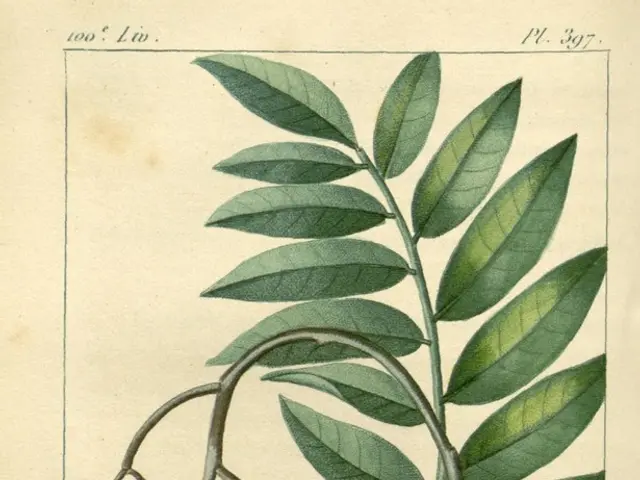Toxic Plant Species Scrophularia Nodosa Under the Spotlight
Knotted Figwort: A Potent Homoeopathic Remedy
Learn about Knotted Figwort, also known as Scrophularia Nodosa, a powerful natural remedy known for its effects on enlarged glands and specific skin issues, particularly breast tumors and eczema.
This herb originating from Europe and Asia has been traditionally valued for its anti-inflammatory and detoxifying properties. It has a long history of being used to treat scrofula (tuberculosis of the lymph glands), and it still maintains relevance in homeopathy for addressing glandular conditions.
Quick Facts:
- Scientific Classification:
- Kingdom: Plantae
- Order: Lamiales
- Family: Scrophulariaceae
- Genus: Scrophularia
- Species: S. nodosa
- Historical Use:
- Traditionally applied to skin ailments and glandular swellings.
What It Does:
Knotted Figwort primarily works on the glands, skin, and mucous membranes, displaying a significant effect on the lymphatic system. Its efficacy can be seen in addressing glandular swelling and inflammation, as well as various skin issues including eczema, ulcerations, and respiratory and digestive conditions tied to scrofulous or tubercular tendencies.
Key Characteristics:
- Treats enlarged and hardened glands, such as those found in Hodgkin's disease, breast tumors, and scrofulous swellings.
- Valuable for skin problems like eczema (especially behind the ears), pruritus (itching), lupus ulcers, and epitheliomas (skin cancer).
- Provides relief from painful, bleeding, and protruding hemorrhoids.
- Exhibits specific action on nodosities and tumors in the breast, especially scirrhous or hard, fibrous breast masses.
Key Symptoms:
- Head: Vertigo, headache, eczema behind the ears.
- Eyes: Photophobia, spots before the eyes, eye pain.
- Ears: Inflammation, ulceration, eczema around the ears.
- Abdomen: Liver pain, colic, rectal pain.
- Respiratory: Dyspnea (shortness of breath), chest pain.
- Skin: Itching, ulcers and nodules.
- Sleep: Drowsiness.
Note: The efficacy of Scrophularia Nodosa may be increased or decreased by various factors, and it may interact with other homeopathic remedies. Consult with a trained homeopath for advice on treatment.
Related Remedies:
- Lobelia Erinus
- Ruta
- Conium
- Asterias
Dosage:
For treating various conditions, Scrophularia Nodosa is generally used in tincture form or in the first potency. Topical application may also be used for skin conditions and enlarged glands. Consult with a trained homeopath for more specific dosage information.
Safety and Precautions:
As with any homeopathic remedy, use caution when taking during pregnancy and lactation. If you have any existing medical conditions or take prescribed medications, consult with a healthcare professional before using Scrophularia Nodosa.
Frequently Asked Questions:
Q: What conditions can Scrophularia Nodosa treat?A: It is primarily used to treat enlarged glands, skin conditions (such as eczema and ulcers), hemorrhoids, breast tumors, and respiratory issues like asthma in scrofulous patients.
Q: Is Scrophularia Nodosa safe for external application?A: Yes, it can be applied topically to treat skin conditions and enlarged glands.
Q: Can this remedy be used for hemorrhoids?A: Yes, Scrophularia Nodosa is effective in treating painful, bleeding, and protruding hemorrhoids.
Q: What are the key symptoms indicating the use of this remedy?A: Key symptoms include enlarged glands, breast tumors, eczema (especially around the ears), painful hemorrhoids, respiratory distress in scrofulous patients, and general skin ailments like ulcers and nodules.
References:
- "Scrophularia Nodosa" – Homeopathy For Health
- "Scrophularia Nodosa" – Homeopathy-Outline.com
- "Homeopathy for Breast Cancer" – Natural News
- "Homeopathy for Cancer" – Homeopathic Path
- "Scrophularia" – American Institute of Homeopathy
Glossary:
- Scrofula: A form of tuberculosis that affects the lymph nodes, particularly in the neck.
- Epithelioma: A type of skin cancer arising from the epithelial tissue.
- Dyspnea: Difficulty in breathing, often associated with respiratory conditions like asthma.
- Nodosities: Abnormal, hard lumps or masses in the body, commonly found in the breasts or lymph nodes.
- Photophobia: An abnormal sensitivity to light that causes discomfort.
- Pruritus: An irritating sensation that makes one want to scratch, commonly referred to as itching.
- Crusta Lactea: A form of eczema commonly seen in infants, affecting the scalp and behind the ears.
- The medicinal plant Scrophularia Nodosa, commonly known as Knotted Figwort, holds value in health-and-wellness and skin-care due to its wide array ofuses in therapies-and-treatments, particularly for addressing specific medical-conditions like skin ailments, glandular swellings, and eczema.
- With a rich history in science, this home-and-garden native plant has shown efficacy in the treatment of various health problems, such as enlarged glands and skin issues, and has remained relevant in the realm of homeopathy for dealing with medical-conditions related to the lymphatic system.
- The importance of Knotted Figwort extends beyond medicinal uses; its key characteristics include treating enlarged and hardened glands, like those found in Hodgkin's disease, skin problems such as eczema, and providing relief from painful hemorrhoids, making it a valuable tool in the global health-and-wellness landscape.
- As with any lifestyle alteration or therapy, it is essential to be aware of safety precautions, such as using caution during pregnancy and lactation, and consulting healthcare professionals when dealing with existing medical-conditions or taking prescribed medications, to ensure a well-rounded approach to maintaining health-and-wellness.





